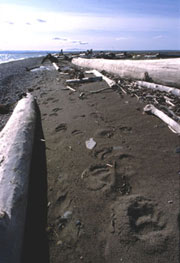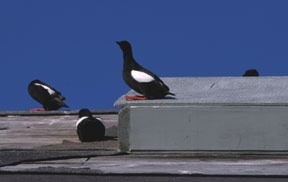Herschel Island Qikiqtaruk Park
Qikiqtaruk means "it is island" in the language of the Inuvialuit. Herschel Island lies just five kilometres off the north coast of the Yukon Territory in the Beaufort Sea. The southern shore faces the mountainous Yukon mainland, while the north shore lies only 90 kilometres south of the permanent pack ice of the Arctic Ocean. Here, where land and sea meet, is found a unique combination of arctic plants, mammals, birds and sea life. Qikiqtaruk is an island of 116 square kilometres. About 15 kilometres by 8 kilometres between shorelines, the rolling tundra terrain ranges in height from sea level to 182 metres high. With a dry, polar climate, a surprising number of plants and animals live on and around the island. There is a small town site on the spit at Pauline Cove that features several substantial buildings from the whaling era of a century ago, as well as archaeological remains of earlier cultures. What to do How to get there If you are rafting or kayaking the Firth River on the Yukon mainland, you can end your trip at Herschel Island. However, you must make prior arrangements for return travel. The island is often shrouded in fog, particularly in late summer, and flights can be delayed for hours or even days. Be prepared with sufficient gear and food. Visitor Safety
Whales travel past Herschel Island on their seasonal migration. In spring, they are usually well off shore using openings in the pack ice as they move east. Bowhead whales can still be seen from Herschel as they migrate westward to the Bering Sea in September. They feed close to the surface on tiny zooplankton known as krill. Beluga whales are also seen from the island at various times during the open water period. Ringed seals are the most common marine mammals in this part of the Arctic, feeding on fish along the edges of the ice during the summer months. The polar bear is a major predator of ringed seals. In the summer they live along the edges of the pack ice across the open water from the island. In winter, a few female bears den on the northern slopes of the island. Red fox are occasionally seen while arctic fox are known to den on the island. Caribou, muskoxen, and grizzly bears are occasionally seen on the island, crossing to Herschel from the mainland, swimming in summer or walking on the ice during the winter. Lemmings, tundra voles and arctic shrews are more common residents. The bird life of Herschel includes over 90 species, 40 of which breed on the island. The island hosts the largest colony of Black Guillemots in the Western Arctic, nesting in the old Anglican mission house. Many other birds summer on the island in more natural sites. Arctic Terns, American Golden-Plovers, and Red-necked Phalaropes make use of the tundra ponds and shingle beaches. Common Eiders nest in the grass tufts and driftwood logs of the beaches while Long-tailed Jaegers and Glaucous Gulls sweep by overhead. The island is also home to a breeding population of Rough-legged Hawks. Snow Buntings, Lapland Longspurs, Common Redpolls, and other tundra-nesting birds begin to arrive on the island in late May to early June. Between the island and the mainland, thousands of Long-tailed Ducks and Surf Scoters gather in July for the annual moult, then gather again in the fall before flying south. From late June to early August, Herschel witnesses an explosion of colour. Its humid maritime climate during the growing season fosters a lush growth of tundra flowers. Nearly 200 plant species are found on Herschel, including a profusion of flowers like vetches, louseworts, arctic lupines, arnicas, and forget-me-nots.
Remains of thousand-year-old dwellings of the Thule culture comprise the earliest known archaeological evidence of island occupation. The Thule people had a highly developed culture and built large villages, some with over 200 people. On the island, their houses were dug into the beach gravel and had driftwood walls covered with hides and sod. Remains of these houses still exist on Qikiqtaruk. When John Franklin, the first European to visit Qikiqtaruk, arrived in 1826, descendants of the Thule were living here. The Qikiqtarukmiut - island people - inhabited at least three villages on the island, including one at Pauline Cove. American whalers, who began hunting bowhead whales in this area in 1889, used Pauline Cove as an overwintering station for almost 20 years. The presence of a large group of foreign whalers attracted Alaskan and Mackenzie Delta Inuit and Gwichin from the Yukon interior, as well as missionaries, police and traders. By the mid-1890s an estimated 1,500 people were overwintering on Herschel Island. Following the collapse of the whaling market in 1907, Herschel's population dwindled until the last non-native left with the abandonment of the RCMP post in 1964. Thirteen historic structures stand on the spit at Pauline Cove. These buildings are related to the whaling period, the Anglican missionaries, and the police, as well as the Hudson Bay Company and other traders. One of the most prominent structures, the Pacific Steam Whaling Company community house, was built in 1893. Also located at the Pauline Cove settlement are semi-subterranean ice houses, various cemeteries, and the archaeological remains of historic and prehistoric cultures. Yukon Heritage Branch continues to research and preserve the island's historic resources. Facilities Park rangers maintain the facilities and offer interpretive assistance at Pauline Cove. The staff includes local rangers who can provide insight into Inuvialuit culture and history. Leave no trace
Further Information
For more information contact: In Whitehorse In Inuvik: For information on historic resources, contact the Yukon Heritage Branch |
Territorial Parks Contents Parks Contents Popular Topics
|
 |
|
|
Contact Us | Site Map | |
 About
About Nature
Nature Culture
Culture